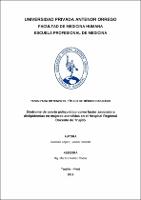Síndrome de ovario poliquístico como factor asociado a dislipidemias en mujeres atendidas en el Hospital Regional Docente de Trujillo

View/
Download
(application/pdf: 443.4Kb)
(application/pdf: 443.4Kb)
Date
2019Author(s)
Guzmán López, Lucero Danelitz
Metadata
Show full item recordAbstract
Objetivo: Determinar si el síndrome de ovario poliquístico es factor asociado a dislipidemias en mujeres atendidas en el Servicio de Ginecología del Hospital Regional Docente de Trujillo en el periodo 2014- 2018.
Material y Métodos: Se llevó a cabo un estudio de tipo analítico, retrospectivo, comparativo, corte transversal; que evaluó a 308 mujeres según criterios de selección establecidos, que se distribuyeron en 2 grupos de pacientes con diagnóstico de Síndrome de ovario poliquístico y sin diagnóstico de ovario poliquístico. Se calculó Odds Ratio y la prueba Chi cuadrado.
Resultados: La frecuencia de dislipidemias en mujeres con síndrome de ovario poliquístico fue de 42.9% mientras que en aquellas que no tuvieron síndrome de ovario poliquístico fue de 31.2%. El síndrome de ovario poliquístico como factor asociado a dislipidemias tuvo un Odds Ratio de 1.656 IC 95% (1.038 – 2.642), el cual fue significativo obteniendo un valor de Chi cuadrado de 4.512 con un p=0.034.
Conclusiones: El síndrome de ovario poliquístico es factor asociado a dislipidemias en mujeres atendidas en el Servicio de Ginecología del Hospital Regional Docente de Trujillo. Objective: To determine if polycystic ovarian syndrome is a factor associated with dyslipidemias in women treated at the Gynecology Service of the Hospital Regional Docente de Trujillo in the period 2014-2018.
Material and Methods: An analytical, retrospective, comparative, cross-sectional study was carried out; which evaluated 308 women according to established selection criteria, which were divided into 2 groups of patients diagnosed with polycystic ovarian syndrome and without diagnosis of polycystic ovary. Odds Ratio and Chi square test were calculated.
Results: The frequency of dyslipidemias in women with polycystic ovary syndrome was 42.9% while in those who did not have polycystic ovary syndrome was 31.2%. The polycystic ovarian syndrome as a factor associated with dyslipidemias had an Odds Ratio of 1,656 IC 95% (1,038 - 2,642), which was significant, obtaining a Chi-square value of 4,512 with a p = 0.034.
Conclusions: The polycystic ovary syndrome is a factor associated with dyslipidemias in women treated at the Gynecology Service of the Hospital Regional Docente de Trujillo.
Collections
- Medicina Humana [2969]

